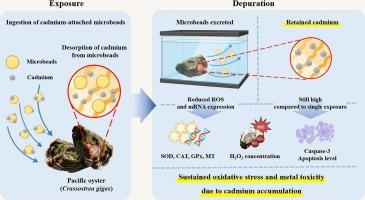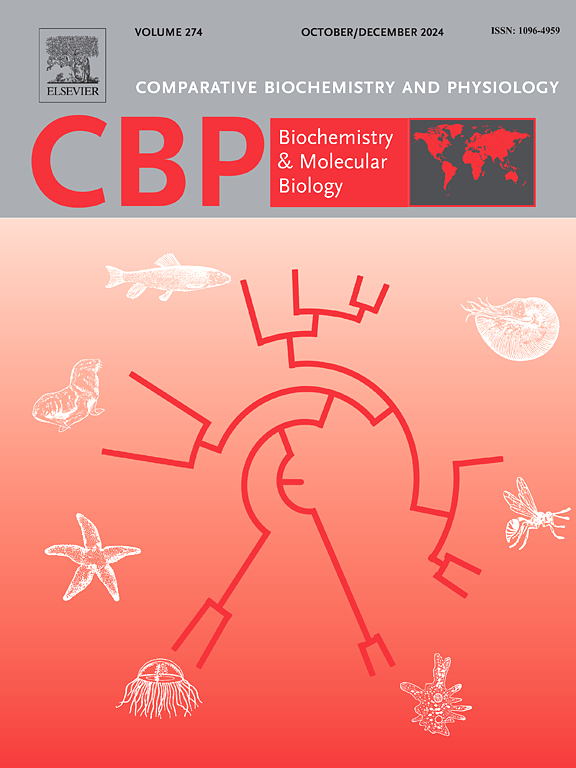Depuration and post-exposure recovery of oxidative stress responses to microplastics and cadmium in Pacific oyster (Crassostrea gigas)
IF 1.8
3区 生物学
Q4 BIOCHEMISTRY & MOLECULAR BIOLOGY
Comparative Biochemistry and Physiology B-Biochemistry & Molecular Biology
Pub Date : 2025-08-18
DOI:10.1016/j.cbpb.2025.111147
引用次数: 0
Abstract
Microplastics and trace metals such as cadmium (Cd) are environmental contaminants commonly co-occurring in marine ecosystems. We aimed to evaluate the impact of combined exposure of Pacific oyster (Crassostrea gigas) to microbeads (MBs) and Cd, focusing on the effects of the depuration process on contaminant removal and stress-related biomarkers. Pacific oysters were exposed to MBs, Cd, and their combination for 48 h, followed by a 72 h depuration process using uncontaminated seawater. We measured the levels of accumulated MBs and Cd in the whole soft tissue of the Pacific oysters to evaluate the degree of contaminant removal. Additionally, the concentrations of hydrogen peroxide were measured and the mRNA expression levels of antioxidant enzymes, metallothionein, and the apoptosis-related gene caspase-3 were analyzed in the Pacific oyster hepatopancreas tissue to evaluate oxidative stress and apoptosis. Our results indicated that Cd was eliminated more slowly than MBs, and the Pacific oysters exposed to combined MB and Cd contaminants maintained higher levels of oxidative stress-related gene expression than those exposed to individual contaminants. These findings suggest that Cd may persist longer in oyster tissues than MBs, potentially leading to prolonged toxicity in the Pacific oyster. Furthermore, in environments where both MBs and Cd are present, MBs can enhance the toxic effects of Cd through a synergistic interaction. Overall, we provide a reference for understanding the depuration and physiological responses of marine bivalves exposed to MBs and Cd.

太平洋牡蛎(长牡蛎)对微塑料和镉氧化应激反应的净化和暴露后恢复
微塑料和镉(Cd)等微量金属是海洋生态系统中常见的环境污染物。我们旨在评估太平洋牡蛎(长牡蛎)对微珠(mb)和Cd的联合暴露的影响,重点关注净化过程对污染物去除和应激相关生物标志物的影响。将太平洋牡蛎暴露于MBs、Cd及其组合48小时,然后使用未受污染的海水进行72小时的净化过程。我们测量了太平洋牡蛎整个软组织中累积的mb和Cd的水平,以评估污染物去除的程度。通过测定过氧化氢浓度,分析抗氧化酶、金属硫蛋白和凋亡相关基因caspase-3 mRNA表达水平,评价氧化应激与凋亡的关系。我们的研究结果表明,Cd的消除速度比MB慢,并且暴露于MB和Cd组合污染物的太平洋牡蛎比暴露于单个污染物的太平洋牡蛎保持更高水平的氧化应激相关基因表达。这些发现表明,Cd在牡蛎组织中的持续时间可能比MBs更长,可能导致太平洋牡蛎的长期毒性。此外,在MBs和Cd同时存在的环境中,MBs可以通过协同相互作用增强Cd的毒性作用。本研究为了解海洋双壳类生物对甲基溴和镉的净化和生理反应提供了参考。
本文章由计算机程序翻译,如有差异,请以英文原文为准。
求助全文
约1分钟内获得全文
求助全文
来源期刊
CiteScore
4.60
自引率
4.50%
发文量
77
审稿时长
22 days
期刊介绍:
Comparative Biochemistry & Physiology (CBP) publishes papers in comparative, environmental and evolutionary physiology.
Part B: Biochemical and Molecular Biology (CBPB), focuses on biochemical physiology, primarily bioenergetics/energy metabolism, cell biology, cellular stress responses, enzymology, intermediary metabolism, macromolecular structure and function, gene regulation, evolutionary genetics. Most studies focus on biochemical or molecular analyses that have clear ramifications for physiological processes.

 求助内容:
求助内容: 应助结果提醒方式:
应助结果提醒方式:


